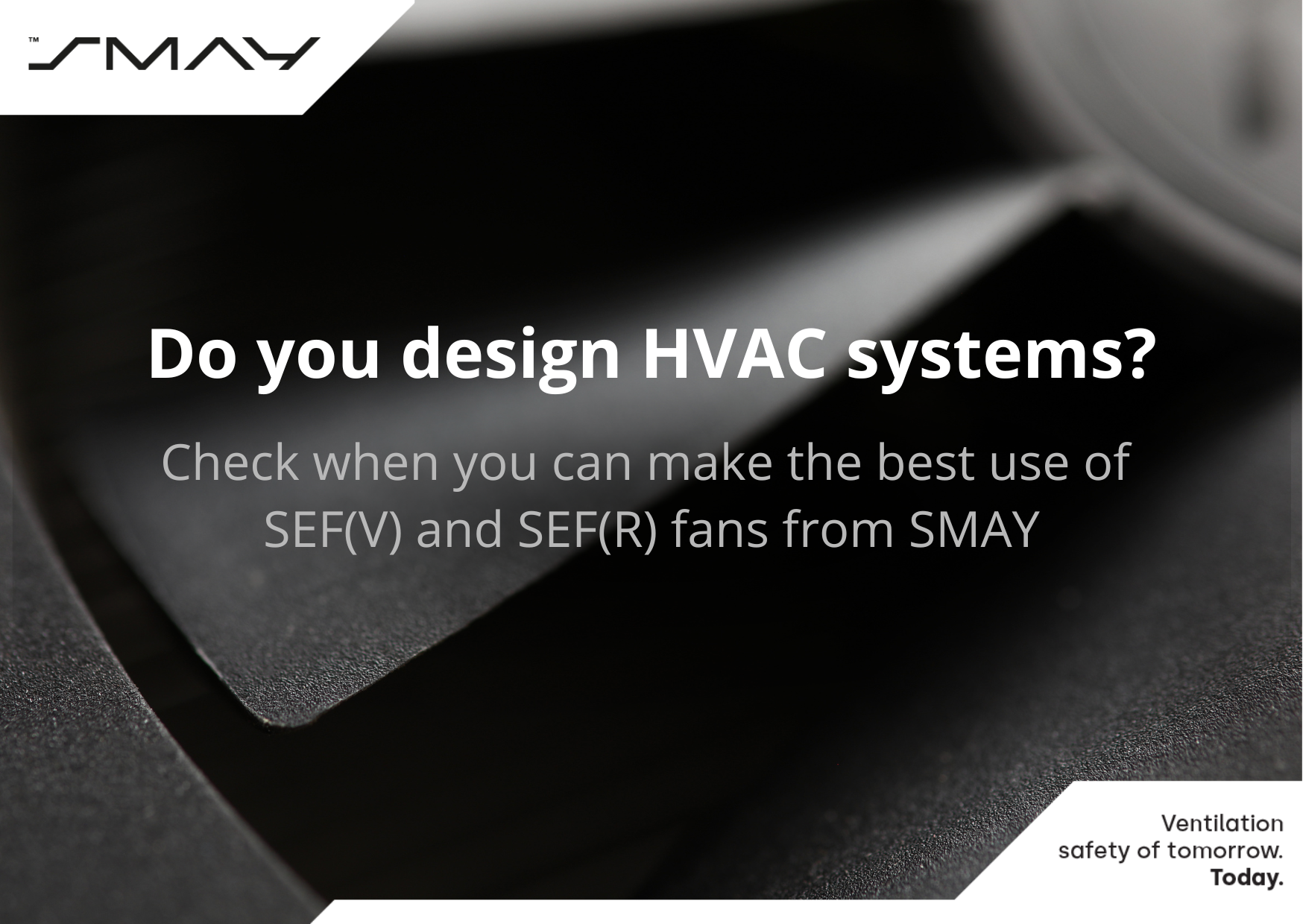Universal Application of SEF(V) and SEF(R) Smoke Exhaust Fans in Various Projects

Designing and engineering a ventilation system depends on many complex factors that challenge the designer at every stage of the project. The use of ventilation products that can be flexibly adjusted to different types of systems minimises the risk of error during installation and optimises the entire design process.
Are you a designer? Check when you can make the best use of axial smoke exhaust fans from SMAY. SEF(V) and SEF(R) fans are a great choice, not only because of their high quality and energy efficiency but also for their universal use in the design process.
Not got enough space? Use a vertical installation of SEF(V) and SEF(R) fans in your design
Plumbing and HVAC system designers often dedicate too much time when it comes to selecting adequate ventilation products that fit the given design. Unfortunately, architects often minimise the space available for ventilation systems. For this reason, it is hard to select the products, which not only provide appropriate performance but also can be placed within the available space inside a building. SEF(V) and SEF(R) fans are also certified for vertical installation. This is a clear advantage when you need to match this product to a specific ventilation system design project. Why is this?
More usable floor space within a building
Certified vertical installation of SEF fans makes it possible to place them inside a field exhaust louvre, which increases the usable floor space within a building due to the absence of shafts inside. To save space when designing a ventilation system, place the SEF fans in a vertical position.
Direct positioning of the fans in a shaft
Due to the vertical installation option, it is possible to place the fans directly in a ventilation shaft. Such a design solution avoids having to modify the architectural design and conceals the elements of the ventilation system in a designated place within the building.
Direct smoke extraction from car park garages
The fans can be installed in a plenum box. It makes it possible to extract smoke directly from a car park garage.
Reliability of the system – guaranteed
You may be wondering whether vertically arranged SEF(V) and SEF(R) fans will work properly. Certification of the vertical installation guarantees that the reliability of the system will be maintained.
The versatility of using SEF fans due to their 100% reversibility operation.
SEF(V) – 70% and SEF(R) – 100% fans from SMAY are reversible. This is good news for HVAC designers because it means that these products can be comprehensively used in various designs. The reversible operation makes it possible to install the fans in different types of buildings and to provide operation in both directions (smoke extraction/compensation). Their greatest advantages for design engineering are the following:
- Two-way operation with identical efficiency when using SEF(R) fans.
- The aerodynamic profile of the fan blades significantly decreases power consumption, which improves the energy efficiency of the system under design.
Higher efficiency and flow parameters
SEF(V)GV fans, due to using a vane, rectify the stream, which makes the air stream uniform and prevents possible additional turbulence directly downstream of the fan. Such a solution significantly increases the efficiency and flow parameters and eliminates any additional pressure loss in the system directly downstream of the fan, which otherwise would be quite difficult to predict. It is recommended that they are used in systems where high reversibility is not required, as well as when a significant proportion of the system resistance is on the discharge side.
How SEF(V) fans lower operating costs
SEF(V) fans are equipped with flow vanes that allow a significant part of the static pressure generated by the axial fan impeller to be recovered. Thanks to their use, the fans achieve high flow parameters combined with low power consumption, which significantly reduces their operating costs. We recommend the vanes when the fans are to be mounted on the discharge side because they significantly reduce turbulence at the fan outlet. The turbulence may significantly increase the pressure loss in ducts (linear and local).
Eliminate the noise, pressure loss and efficiency drops with SEF(R) fans
100% reversible fans are generally considered low-efficiency devices because, in some of these products, blades are mounted alternately and rotate at 180° relative to each other. Such a practice causes additional internal efficiency loss (about 15%) and pressure loss (about 30%), as well as extensive noise emission. What is more, this solution is disadvantageous due to the additional dynamic load caused by the non-uniform inflow on the rotor crown. This may result in faster wear and tear on the fan impeller. Blades are sometimes stamped from sheet metal, therefore it might not be possible to use any aerodynamic profiles, which also lowers parameters and increases noise.
Aerodynamic profiles of SEF(R) fan blades
Due to aerodynamically profiled symmetrical blades, there is no additional loss and the energy efficiency remains at a very high level. SEF(R) fan impellers are a result of the long-standing work of engineers, who have long been developing the perfect shape of the rotor. The impellers provide exactly the same flow in both directions while maintaining high energy efficiency and low noise emission.
Dual action SEF fans from SMAY
What is more, SEF fans are dual-function fans, which makes it possible to use them both in firefighting and domestic applications. They are fully capable of working with an inverter, which allows the entire system to adapt dynamically, even when several operating points are required. SEF(R) fans are normally fitted with PTC sensors as standard and SEF(V) fans can be fitted with such sensors as an optional extra.



